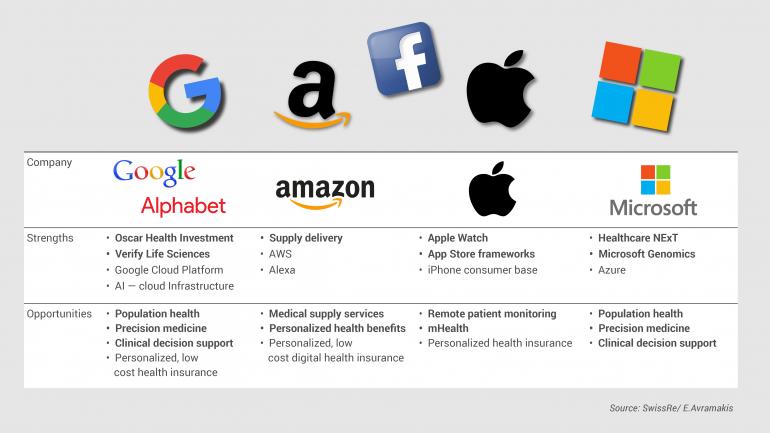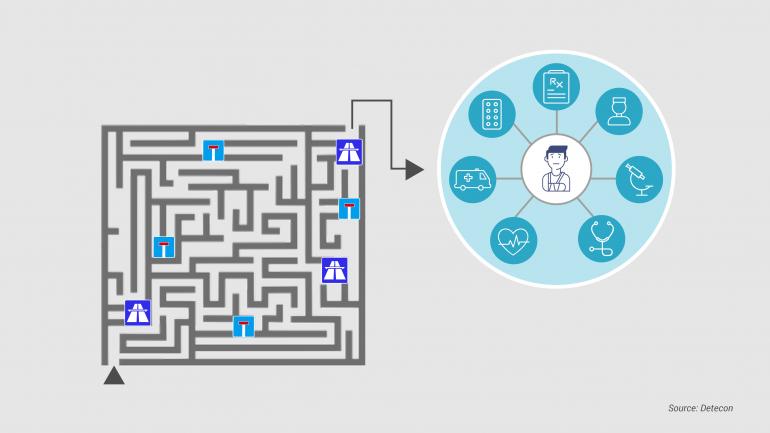Digitalization has taken wing in the health care industry. There are several factors fueling this fast growth: government funding programs and regulatory obligations, new ecosystems entering the market, and the increasing acceptance of patients to engage with digitalized ecosystems are major contributors. In this article of our Detecon experts Christian Hammann, Fabian Brüning, and Pascal Frank, you will read why the “courage to leave gaps” is good and how dead ends in ecosystem selection can be avoided.
Research has revealed that 75 percent of people surveyed are using freely available health and fitness apps today (source: Bitcom Research 2020). More than 50 percent of respondents can imagine joining a health care ecosystem that would enable them (for instance) to consult their attending physician per video or to receive and use electronic prescriptions. And more than 73 percent of respondents in nearly all age groups can imagine having an electronic health file.
What is an ecosystem really?
An ecosystem (a term from biology) can be understood as an open, dynamic complex of communities that function as units in interaction with and dependency on one another within a definable environment (source). Balanced interactions are essential if the ecosystem is to function as a stable entity. It must be robust enough to withstand at all times the impact of both internal and external factors that might otherwise destabilize the interplay of the units within the ecosystem.
In nature, these processes play out organically over very long periods of time, and evolution has produced an indescribable variety of ecosystems — and caused just as many ecosystems to perish.
If we now take the systematics of the ecosystem and apply it to the health care market, a number of points become clear in today's fast-moving times.
Health ecosystems develop solely inorganically and as the consequence of specific efforts
Smaller providers such as Docbox, Bluecare, or Post-E-Health have set out to build communication platforms that enable doctors, patients, or insurers to communicate with one another as digitally as possible on one platform in the interests of securing the best possible end-to-end patient orientation. But large international technology groups such as Google, Amazon, Microsoft, and Apple have also discovered the market for themselves and are establishing their own solutions for networking all players in the health care system within a completely digital system in the future. The focus has been broadened beyond the traditional needs of digital communication during medical treatment to include the use of smart devices to record the health status of patients and the resulting possible support of disease diagnoses and treatment choices. In addition, certain ecosystems are prescribed by regulation so that (for example) the electronic patient file can be used. Figure 1 shows how the major technology providers are positioning themselves on the market.

Figure 1: Positioning of Technology Providers on the Market
They disappear as quickly as they came
All the new health care ecosystem providers want a piece of the big pie. Once again, we can turn to biology for an analogy: “survival of the fittest” — only those with the most effective adaptation will survive.
If the regulatory requirements governing data protection, transparency, and freedom of movement become too constraining for the large international providers, the local market could become unattractive. It would not be the first time that major providers invested millions in new product ideas, only to withdraw the new product from the market for lack of an adequate profit margin. Smaller providers, on the other hand, could run out of steam along the way. Especially when a majority of customers turn to an alternative ecosystem.
Consequences for the alignment of digitalization to one ecosystem
It would be a mistake, however, to allow these concerns to stop progress. The potential that lies dormant in patient-centric collaboration and data exchange within ecosystems is far too great for that.
It would be just as wrong to commit to only one ecosystem — after all, many ecosystems emphasize different aspects, ranging from straightforward communication to the collection of health and life data.
Important: having your own digitalization strategy
Where do I want to go? What do I want to digitalize in the next few years? What does my target landscape where I map relevant business processes as a health care partner look like, and what form does my end-to-end patient orientation take?
Once these questions have been answered, ecosystems can be specifically evaluated so that I do not end up with an expensive, yet ineffective array of various platforms and solutions.
Also important: effective ecosystems are open and based on standards
None of the groups on the health care market should be excluded right from the start. The use of standards is also important. In the ideal case, for example, an appointment with a physician created in one ecosystem can be received and processed in another ecosystem and vice versa.
Over the years, standards for interfaces, imaging processes, and file formats have been developed within the technical solutions for the health care market. If these standards have been incorporated into the chosen ecosystem, the risk of digitalizing yourself into a dead end is greatly reduced. Dead ends must be avoided when choosing an ecosystem.

Figure 2: Avoiding Dead Ends When Selecting an Ecosystem
If technology providers succeed in making their ecosystems so open and standardized that individual platforms can be used in symbiosis with one another instead of competing and excluding one another, the health care market will be able to build on the crossover, sustainable, and effective digitalization foundation that is so urgently needed.
Here you can find our article "Service Excellence in Health Care: Compulsory Figures or Freestyle?"








